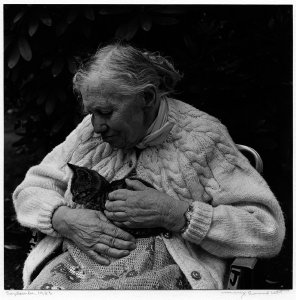Helmi Juvonen
Helmi Dagmar Juvonen, known in her day simply as Helmi, was a prolific artist whose creativity embraced many media - paintings, drawings, prints, ceramics, and ceramics. She was particularly drawn to the ceremonies and arts of Northwest native culture - masks, dances, costumes, and totemic animals. The artist developed a rapport with particular tribes, including the Lummi, Swinomish, Muckleshoot, Makah, and Yakama, who invited her to participate in their rituals. During the most sacred ceremonies, she relinquished her sketchbook and relied on memory for documentation. Helmi also devoted years to studying and drawing Northwest Coast Indian and South Pacific objects from the Washington State Museum, which became the Burke Museum, University of Washington. In later life, the artist was inspired by the book Primitive Art (1927) by anthropologist Franz Boas.
The Early Years
Born in Butte Montana in 1903, Helmi attended the Cornish School (now Cornish College of the Arts) and audited engineering and mechanical drawing classes at the University of Washington. During World War II, the artist sketched isometric perspective drawings and made full-size patterns for planes at the Boeing Aircraft Company. She also supported herself, at times, as a commercial artist.
Becoming Helmi
Spirited and independent, Helmi forged her own unconventional path through life. Living on the edge of poverty in a small shack above Alki Beach, she sold prints at the Pike Street Market for 50 cents apiece. Her talents were well-recognized and works were purchased by many important Seattle collectors. Supported in part by Dr. Richard Fuller, the founding director of the Seattle Art Museum who acquired her work for the collection, the artist was friends with many Northwest art world luminaries, including Morris Graves.
During the 1950s, a period of suppression and conformity in American life, Helmi's eccentricities alarmed neighbors and family who disapproved of her creative career. The artist's infatuation and obsession with Mark Tobey, the most renowned of the Pacific Northwest mystic painters, embarrassed Tobey as well as his many supporters. Diagnosed with schizophrenia (now recognized as manic-depression), she was committed to a mental institution in Elma, Washington, where she lived the final 26 years of her life. Here, she received artists and supporters, who helped her achieve recognition during her lifetime through many art museum exhibitions.
Transcending Boundaries
Native American culture nurtured Helmi's creative spirit and enabled her to transcend the boundaries of ordinary life, poverty, and decades in a mental asylum. Her interest in understanding the origins of human culture, especially as it addressed the dichotomies of good and evil, led her to explore these themes in diverse spiritual traditions - Judeo-Christian, Tibetan Buddhism, and the Baha'i faith.
The Collection
This selection of about 60 artworks in diverse media is drawn entirely from the Whatcom Museum's collection of her work, which numbers 250 objects. Some of her finest pieces are highlighted: gouache paintings of petroglyphs from Nanaimo, Vancouver Island; the Makah Wolf Dance experienced at Neah Bay; and a lithograph of the Speqpequd: Winter Dance Time, sketched when Helmi attended ceremonial dances in the Swinomish Reservation Longhouse at La Conner in 1946-47.
This exhibition suggests the complexity of Helmi's vision by displaying some or her most unusual artworks, including Mammalian Mirror, where images and symbols from a variety of cultures converge. The influences of Mark Tobey, Pablo Picasso, Scandinavian Folk Art, and the story of Adam and Eve in the Garden of Eden on Helmi's style will also be examined.
Many artworks are gifts from Helmi and her life-long friend Wesley Wehr, the artist and Burke Museum paleontologist, who guest-curated many of her exhibitions, including the retrospective exhibition at the Whatcom Museum in 1985. Another large group of artworks was donated by Dr. Ulrich and Stella Fritzche. Dr. Fritzche, author of the book, Helmi Dagmar Juvonen: Her Life and Work, a Chronicle, has contributed to our understanding of the artist's biography.
Curated and written by Barbara Matilsky
